
Salty Sam’s Fun Blog for Children
Number 319
Woodland
Hello Everyone

You already know that the rainforests hold the greatest variety of wildlife on Earth.
But our own woodland holds a multitude of creatures too.
When we go for a walk in the woods behind Auntie Alice’s cottage we have a lot of fun seeing what we can spot.
There are roe deer in the wood and they can be quite timid. At night you can see badgers and foxes. But there are hundreds of little creatures too.
ln fact, the whole woodland is a community living together.
There can be thousands of species of creature living together in a woodland community.
Woodland habitat refers to the soil, climate and types of plants, fungi, animals and insects that live there.
Woods are often full of life in the day time and the night time too.
You have to look carefully if you want to see little creatures like caterpillars and snails. The birds are looking out for them all the time when they are looking for things to eat!
Woods can vary in their character when they contain different types of trees. A forest full of pine trees will be different from a beech wood for example. There will be more plants growing on the forest floor in deciduous woodland like an oak or beech wood than a coniferous woodland because a carpet of pine needles on the ground deters other plant life.
And just one tree can be a habitat in itself. lt can provide a home for lichen, mosses, fungi, insects, birds and even, sometimes, bats. And underground the trees are connected to each other via networks of fungi. These fungi, which look more like threads than mushrooms, help the trees to take up nutrients and also provide a kind of communication system that trees can understand.
ln Britain, and other countries too, woodlands are called ‘climax vegetation’.
This means that if there were no humans, and nature was completely left to itself, the whole country would be taken over by woodland. This is because woods are self-renewing. Trees can produce seed which rolls or blows away to produce new trees and over time trees would colonize the land.
lf humans left the planet, eventually all the buildings would crumble away, the roads would crack up and the whole country would be one big wood.
This process is called rewilding.
Most woodland today is managed by people though.
Sometimes they are called foresters. They might manage woods for timber, food or even recreation. Have you ever been paintballing?

These woodland managers have special names for things in the woods. They call tall trees ‘stands’ and the paths that run through the woods ‘rides’.
They try to arrange for these rides to run from east to west so that they let in lots of sunshine and daylight because this is good for the trees. The rides tend to wend their way through the woodland in a curvy fashion – straight lines can produce wind tunnels and strong wind could damage the trees.
Many plants grow at the sides of the rides that won’t grow deep inside the wood because there is not enough light for them there. Many of these plants are flowers like violets and primroses. Brambles can become too invasive though and are often cleared away in a managed wood.
Glades here and there are good for the eco-system (wildlife living together) too.
They let in sunlight and give small plants a chance to grow.
Did you know that 90% of a tree’s roots are in the top 60cm of the soil around the tree? They stretch out a long way; for many, many metres, in fact. They want to be near the surface to get a good supply of water, oxygen and nutrients. They need all of these to thrive.
Of course the roots from trees will intermingle with their neighbours’ roots and scientists have discovered that some sort of communication travels between trees in this underground world.
The trees in a wood will be of different ages and this is important. New trees replace old ones over time. When trees start to hollow out they provide a refuge for birds like owls and woodpeckers and also some species of bats.
Bats love hunting in woodland at night because it provides them with a lot of food and places to perch whilst they are out of their roosts (homes) and foraging.
Dead wood is actually vitally important for keeping a woodland healthy because it is recycled back into the soil to provide humus. As it rots it provides food for a huge number of species of fungus and insects. lnsects can become food for birds and hedgehogs.
There are about 1,800 species of invertebrates that feed on decaying wood.
Some woods are coppiced. This means young wood stems are harvested. When the tree grows back, it grows back quickly and there is soon another harvest to take. This practice can actually lengthen the lives of the trees too. The trees often have multi-stems rather than one trunk so you can easy see which woods have been coppiced.
The harvested shoots are used to make fences and poles and woven goods like baskets. They can also be used for fuel in stoves and incinerators. This fuel is called bio fuel.
The trees that are usually coppiced are willow, hazel and chestnut.
The top, bushy parts of hazel are traditionally used in the garden to stake plants like peas that have tendrils and like to climb up some kind of support.
The coppicing is done in the winter when there are no leaves on the trees and the wood sap is down.
Sometimes horses are used to pull logs out of the woods. Chains are attached to the logs and the horses drag them along the ground. The horses can manoeuvre between the trees much more easily than tractors or other machinery. They don’t chew up the ground either like big tractor wheels do.
Coppiced forests often have more biodiversity than others because more sunlight is let in. You may find dormice and butterflies in this kind of habitat.
lf you take a walk in a woodland and see lots of furrows and hollows in the ground, there is a good chance that these are an indication that ancient peoples once worked in there. Maybe they were charcoal makers or woodcutters that made furniture. Maybe they made the forest their home.
We certainly love walking in the woods.
lf you don’t have a woodland near you, there is probably a park you can visit instead to see trees and squirrels and butterflies.
Bye bye everyone – don’t forget to subscribe to my blog!
lf you like my blog, please support it by telling all your friends and followers about it.
Thank you!
And see you again next Fun Friday!
Love and kisses
Salty Sam

www.christina-sinclair.com


Bill and Bob’s Joke of the Week![]()
![]()
Bill: What did the termite say when he walked into a bar?
Bob: l don’t know. What did the termite say when he walked into a bar?
Bill: “ls the bar tender tonight?”

Salty Sam © Christina Sinclair 2015
Unauthorized use and/or duplication of material from this blog without express and written permission from this blog’s author and owner is strictly prohibited.
Links may be used to www.christina-sinclair.com

Picture Gallery
 Oak woodland
Oak woodland
 Beech woodland
Beech woodland
 Mature coppice
Mature coppice
(geographic.org)
 Conifers
Conifers
When trees are spaced apart there is room for grass and other plants to grow
 Dead wood left in a forest does not harm other trees
Dead wood left in a forest does not harm other trees
 Coppice products
Coppice products
 Primrose
Primrose


 THE SALTY SAM NEWS DESK
THE SALTY SAM NEWS DESK

While the Rocky Bay builders, Reckitt and Stackett, were busy re-thatching Auntie Alice’s cottage this week, she still had to get on with her life as normal.
She feeds and waters the chickens and doves as well as all her pets every day.
She continues to go into town to deliver eggs to Betty Cutterbuck in the Rocky Bay Tearooms. I think she likes catching up with town gossip while she is down there too!
She looks after the children when they came round to play, and she cooks and knits and bakes and is doing all the things that she always does.
She also went to help out at the Rocky Bay Animal Rescue Shelter, where abandoned pets are sometimes brought in from the local area one day earlier in the week.
When she got there she found that two tortoises had been brought in.
The other volunteers were a bit concerned about them.
It was difficult to know how old they were but because tortoises live for many years – it was possible they had many more years to live.
Taking on a tortoise is a really big commitment. It isn’t like you to have to take them out for a walk every day on a lead or anything, but they can live up to 100 years!
They will be with you for a long time to come.
Nobody seemed to be interested in the tortoises. They were all looking at the kittens and puppies and the tortoises were constantly being overlooked.
So what do you think Auntie Alice did?
Yes, you’ve guessed it, she brought them home with her.
She already had one tortoise, so now her tortoise would have some new friends.
She hoped they would all like each other.
She was a bit worried about putting them all out in the garden with all the building work going on though.
She already knew that with such a big garden the tortoises were likely to get lost under a hedge somewhere. You need to know where your tortoise is when you get your garden tools and lawn-mower out!
She would paint a letter or symbol on their shells in a bright colour later when she had more time; she would wait for the children to name her new pets first.
So she put them in a pen in the shed for the moment to keep them safe and covered the floor in straw to make them comfortable – and well away from the builders!
Luckily, Auntie Alice already knows how to look after tortoises.

When the temperatures drop at the end of the summer it is time to start thinking about putting your tortoise into hibernation once they are over three years old. They have to be a good weight and in good health before you tuck them up for their long sleep.
Because tortoises come from warm countries, when they wake up in March, it will probably be too cold for them to go outside, so keeping them in a vivarium for a while is the solution.
At the beginning of September when the nights are becoming chilly, they will need to be brought inside and put into a vivarium too and by end of October you can start to reduce the night and day temperatures slowly over a couple of weeks.
When the tortoise stops showing an interest in eating, you have to continue reducing the temperature and start counting the days from when they last fed.
After two weeks of not feeding, the tortoise should have emptied its stomach contents and will be ready for hibernation.
Tortoises have to be kept at a constant temperature when they are hibernating. This is between three to seven degrees Celsius. If this is not done, a tortoise can keep waking up and this is not a good idea.
You need to put your tortoise in a strong plastic box at least 30cm/12” deep with a ventilated lid.
It needs to be filled up half way with dry garden compost. Even if it feels dry, the compost will naturally have some moisture content in it which will help prevent the tortoise dehydrating during hibernation. Dehydration for tortoises can have devastating consequences.
If the tortoise is still very active, you need to try cooling it for another week before you put it in the box.
You place the tortoise in the box and let it settle for a couple of hours, then put some more loose compost in the box around the edge banked up the sides. The tortoise will bury itself. Their breathing will become so slow that there will be enough air coming through the compost to keep them alive. They bury themselves like this in the wild.
Because the tortoise is in compost and not a straw-filled box, the temperature around them will remain at the constant level they require.
A min-max thermometer put in with the tortoise will give you information that conditions are right for your tortoise’s hibernation. You need to check on the box every couple of weeks – you can write a note in your diary if you think you will forget!
Auntie Alice has a wall chart in her kitchen to make notes on – you need one of those when your life is as busy as hers is!
You must not put the tortoise in a place where frost will get to the box, so it must be kept inside; somewhere like on a shelf in a brick garage. You can’t leave the box on the floor.
You need to make sure no mouse can get into the box.
And then you can bring the box into a slightly warmer area in March.
You have to let your tortoise wake up by itself.
Then you can put it in a vivarium that has been warmed up to twenty-two degrees Celsius.
After a couple of days, you need to remove the tortoise and bathe it in luke warm water in a shallow bath for about ten minutes to re-hydrate it and then return it to the warmth of the vivarium . This should be done every day for ten days and during that time every other day you should increase the temperature a degree until it gets to twenty eight degrees Celsius.
If the spring temperatures are very warm, the tortoise can go for a walk in the garden and then be brought back into the vivarium for the nights as these will still be chilly.
You must also bring your tortoise in if there is an especially heavy downpour.
Even in summer, tortoises need to be put away at night. Any dampness at night is really bad for them. Auntie Alice has a place in one of her sheds where they can be put away safely.
A tortoise pen left out in the garden must have some shade in it for when the sun gets really hot and shelter from rain as well.
Tortoises are slow-moving and cold-blooded so you really have to make sure that they are always kept in conditions that are right for them. They need a responsible human to look after them properly otherwise they will not survive.
Different types of tortoises need different types of food, so you will have to check on that when you get a tortoise. Baby tortoises need softer or crispier foods than adults because they only have tiny jaws and find it difficult to eat harder food.
Tortoises can eat most vegetables and a lot of them like fruit. Some may need supplements. They like going for a walk in the sunshine in the summer. It is good for their shell.
Always keep some water in a shallow tray for the tortoise to access and sink it into the floor of their enclosure so that it can’t flip it over. The tray should be shallow enough so that your tortoise can easily stand in it and can place its head in the water without being completely submerged. The water needs to be replaced with fresh water every day. They don’t want their water to be really cold.
It is important that tortoises stay hydrated especially when they are babies.
In the past, people used to decorate their pet’s shells with rings – we know not to do this now. They have nerves in their shells; they are not like our finger nails.
Don’t pick the tortoise up unless you have to. They don’t much like being picked up by people they don’t know either because they get stressed.
They must never be dropped! This is really important. Don’t accidentally step on them either. Don’t let them walk around the kitchen floor where this could easily happen.
Auntie Alice will put all the tortoises back in her tortoise pen after the builders have gone and the garden is peaceful again. When the two new ones are settled in, they will be able to go for a long walk in the garden.
She will have to buy two more hibernation boxes now.
I am sure they will like their new home.

A very large vivarium

*********************
TO ADVERTISE ON THIS BLOG
PLEASE CONTACT:
christina.sinclair.ads@aol.co.uk
*********************


Quick Quiz
Can you complete these words to find creatures of the forest?
- w _ l _ b _ a _
- b _ a _
- d _ e _
- s _ u _ r _ e _
- w _ l _
- f _ x
- b _ d _ e _
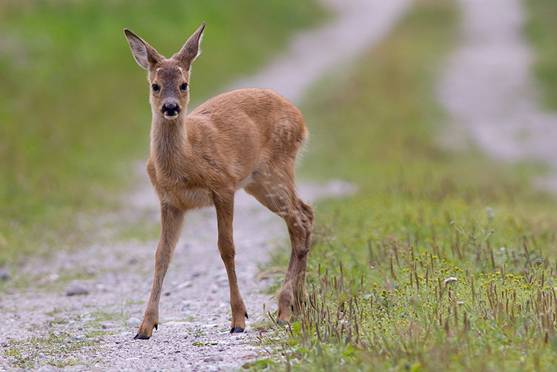



lt’s the Weekend!
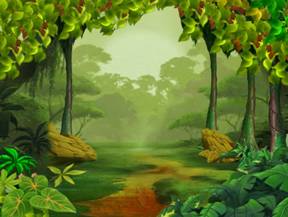
HOW TO MAKE A TWO-TONED GREEN WlNTER SWEATER FOR A 12” DOLL
This sweater is perfect for a walk on a chilly spring day and this is just the time of year to see all the leaves coming out in the woods and hedgerows.
GREEN SWEATER – FRONT AND BACK (KNIT TWO)
Using 3¾mm knitting needles and dark green dk yarn cast on 15 stitches
K1, p1 repeat these 2 stitches to the last stitch k1
P1, k1 repeat these 2 stitches to the last stitch p1
K1, p1 repeat these 2 stitches to the last stitch k1
P1, k1 repeat these 2 stitches to the last stitch p1 (4 rows of 1×1 rib)
Change to 4mm needles
Knit 22 rows of stocking stitch
Change to light green dk yarn
Knit 6 rows of stocking stitch
Purl 1 row
Purl 1 row
Cast off
SLEEVES (KNIT TWO)
Using 3¾mm knitting needles and dark green dk yarn cast on 10 stitches
K1, p1 repeat these 2 stitches to the last stitch k1
K1, p1 repeat these 2 stitches to the last stitch k1 (2 rows of 1×1 rib)
Change to 4mm needles
Knit 14 rows of stocking stitch
Change to light green
Knit 6 rows of stocking stitch
Cast off
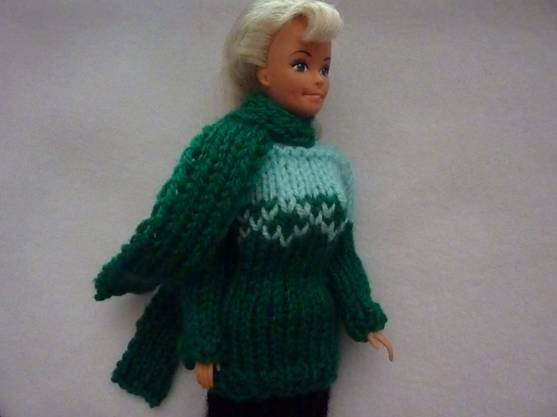
TO MAKE UP
Embroider a pattern onto the front of the sweater using Swiss darning before making the garment up. Make sure there are no loops left behind the knitting to catch on the doll when you dress her.
The pattern needs to be centred onto the knitting – there is a row each side left without pattern so the pattern is 13 columns of knitting across.
X X X X
X X X X X X
X X X
X X X X X X
X X X X
You will probably find it easier to work upwards and across rather than downwards.
Sew the garment together using over-sew stitching with right sides together.
- Sew together the shoulder seams making sure there is room for your doll’s head to go through
- Sew the tops of the sleeves to the shoulders
- Sew the side and underarm seams
- Tidy all the ends of yarn into the seams
SCARF (KNIT ONE)
Using 3¾mm knitting needles and dark green dk yarn cast on 8 stitches
K1, p1 repeat these 2 stitches to the end of the row
K1, p1 repeat these 2 stitches to the end of the row
S1,(p1, k1) repeat these last 2 stitches to the last stitch p1
Repeat this row until the scarf measures 36cm/14½ inches
(100 rows of 1×1 rib)
Cast off
Pull the yarn left at each end through the ends of the scarf to neaten.
TIP
Pull the scarf from each end to even out the knitting a little
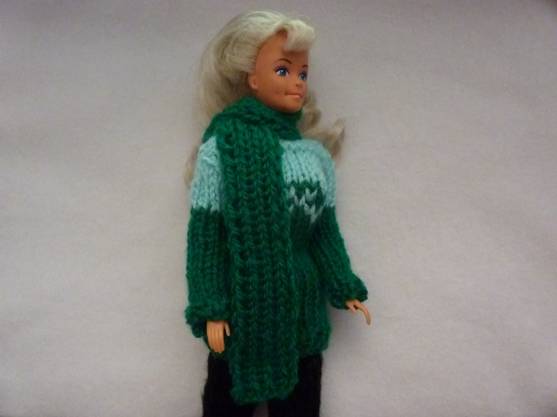
Please note that the material on this blog is for personal use and for use in classrooms only.
It is a copyright infringement and, therefore, illegal under international law to sell items made with these patterns.
Use of the toys and projects is at your own risk.
©Christina Sinclair Designs 2015


Quick Quiz Answers
- wild boar
- bear
- deer
- squirrel
- wolf
- fox
- badger
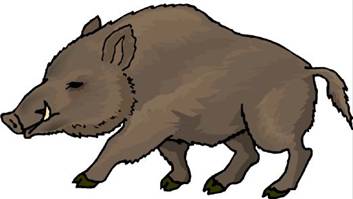
A wild boar

Woodland flowers thrive in the shade

